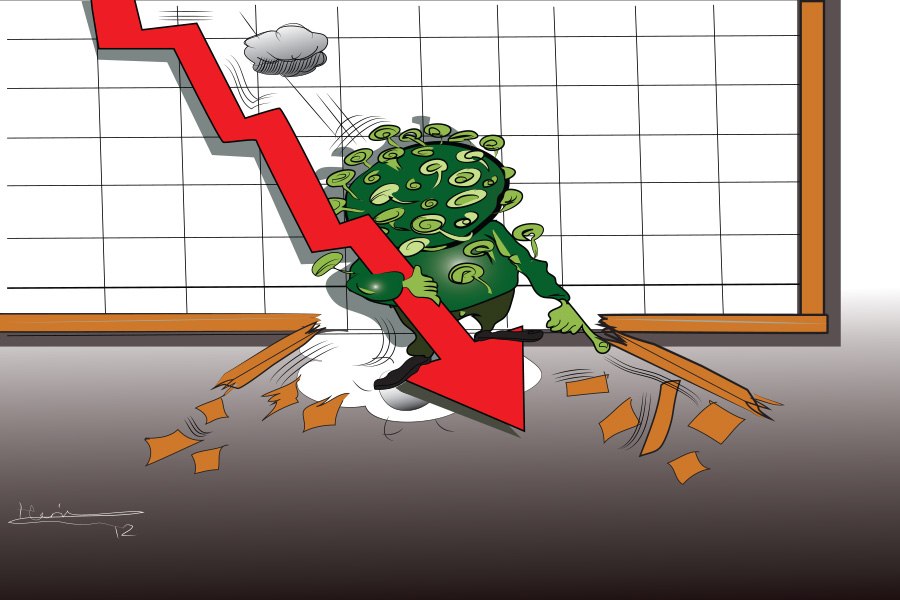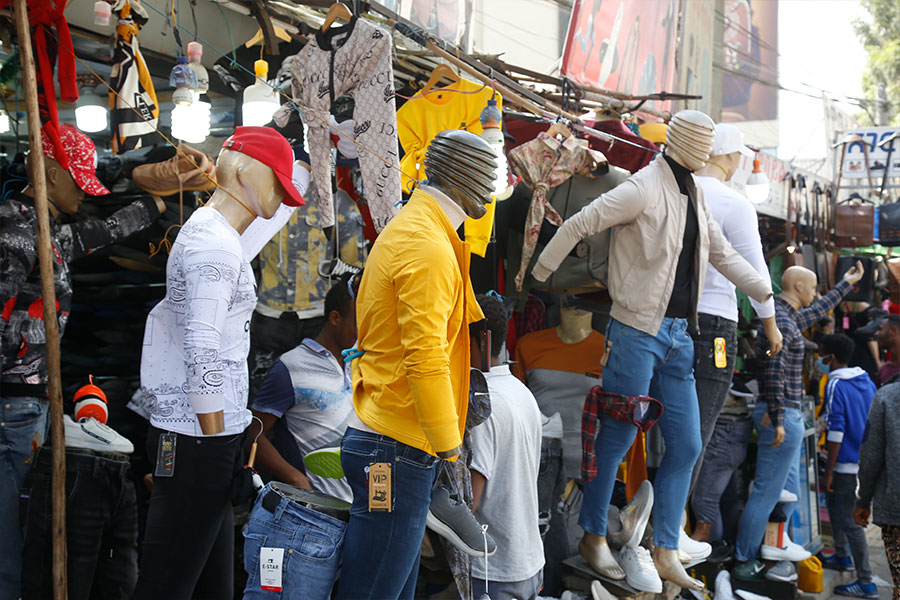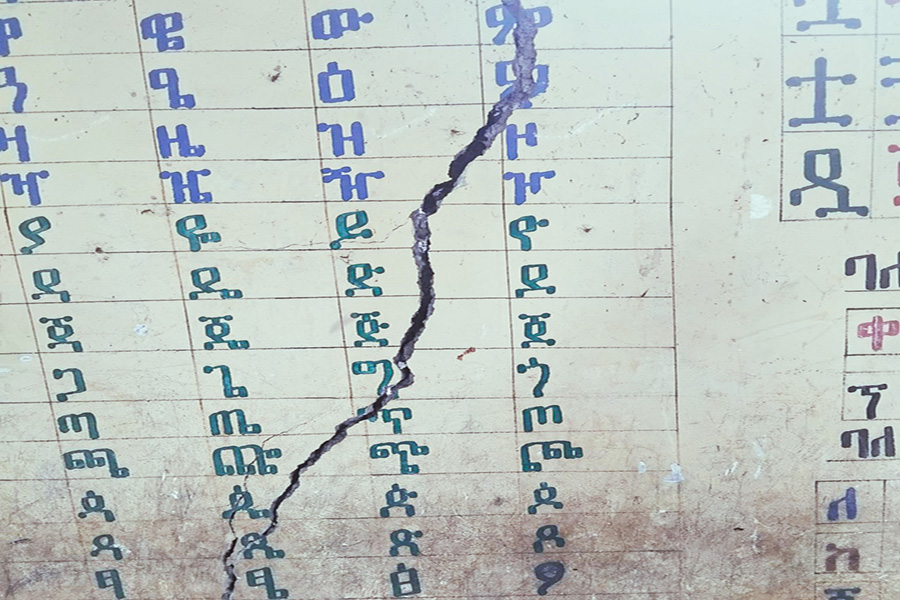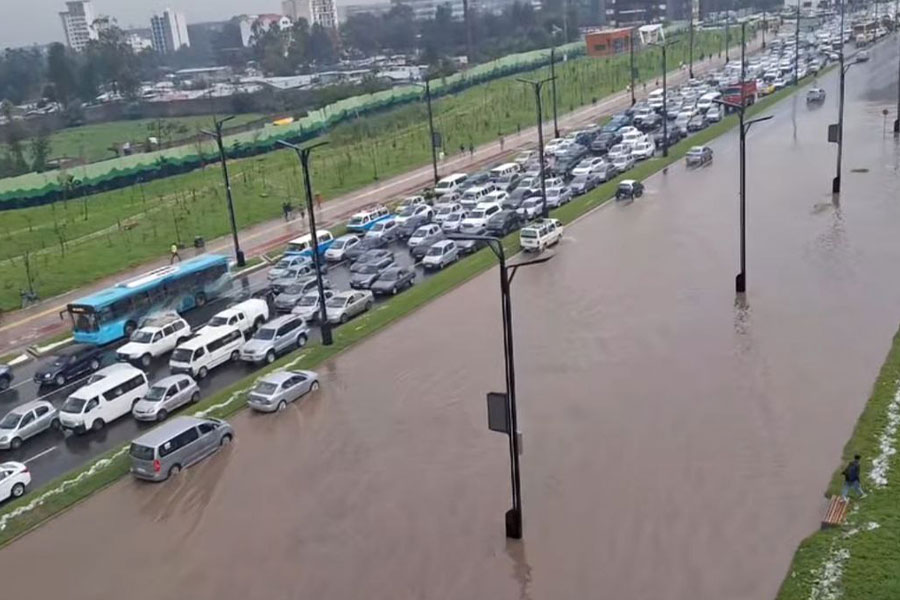
Agenda | Aug 16,2020
It is one of the seven rivers that flow across Addis Ababa, snaking its way down from the hills of Yeka to a new neighbourhood on the outskirts of the capital - Goro. The narrow streets along the riverbank were filled last week with debris. Water that should have gone down the drainage system, clogged with plastic bags and garbage, formed large puddles. A putrid smell lingered in the air.
Bridges and walkways were submerged; some roads had crumpled, and homes were knocked off their foundations. The area resembled a war zone more than it did a residential neighbourhood.
The torrential rainfall caused flooding that swept through last week, leaving its conspicuous mark behind. Residents were scrambling among the havoc to collect what remained of their livelihoods three days after the flash flooding washed away everything in its path. Mattresses, furniture, and clothes were still floating in the filthy water polluted by latrines overflowing during the rain.
Soaked debris was scattered across the yard of a compound that had lost its fencing to the flood. Most houses that had stood inside were no longer there. The wreckage remained of the flood-foundered homes.
Alemtsehay Mulualem sat on a wooden chair. The mother of three was in a state of despair. Her house, and everything inside, were swept away.
“There was nothing I could have done,” Alemtsehay told Fortune. “Almost everything we had is gone.”
The flood ruined six of the houses her family rented as the only source of income. Part of the iron roofing on the buildings that survived was also mopped away by the strong winds that accompanied the heavy rains on that fateful day: July 31, 2022. Alemtsehay sent her children to seek shelter with family members. She was still marooned inside her home, which resembled a lonely island amid a sea of rainwater and trash.
Mekdes Yideg, a two-year-old tenant, recalled how terrifying the incident was.
“I noticed small gushes of water entering my room from the door,” Mekdes remembers. “In minutes, the water was up to my knees.”
There was nothing she could do but flee for her life. From a distance, Mekdes watched in horror as homes began shifting off their foundation and slowly sinking under the unrelenting water.
“I don’t even have clothes to change into,” she said.
Though unnerving, Alemtsehay and Mekdes’ experience is difficult to compare to what Genet Jemal and her neighbours went through.
This residential area near Addis Abeba's Goro neighbourhood was among the victims of flooding last week that destroyed nearly three dozen homes in the capital.
Genet has lived in a two-bedroom mud house in the Addis Ketema District for over two decades. She shared her home, close to a river that flows near Amanuel Mental Hospital, with her husband and their three children. More than a dozen mud houses surround Genet’s homestead. Heavy floods caused a 20-metre-long warehouse on the high ground adjacent to the neighbourhood to collapse. Genet’s home was in the way.
“The flood was everywhere,” she recalled. “It took my son.”
Her son, Eyob Woldeshewa, 18, and another person had bravely gone into one of the neighbours’ houses to rescue a child trapped inside. Only one of them returned. It is the most heartbreaking story brought on by the heavy rains and floods that have gripped the capital in recent weeks. Eyob was one of two who lost their lives to flooding last week. More than five were hospitalised for injuries.
Last Sunday’s tempest inundated the city – roads were submerged, cars were stranded, and buildings were damaged. According to Yikfelew Woldemeskel, deputy head of Addis Abeba Fire & Disaster Risk Management Commission, the floods damaged property in six districts. Nearly three dozen homes were destroyed, while the members of 82 households have been displaced.
Officials have yet to estimate the value of assets lost to the floods.
Many parts of the capital, especially areas along riverbanks, are vulnerable to riverine floods. Often, these locations are inhabited by low-income families and individuals who cannot afford to move away from the low-lying floodplains and unstable hillsides. The Commission identified that a little more than 120,000 houses in Addis Abeba, most of which lie along riverbanks, are vulnerable to flooding.
The risk is not over as meteorologists continue to warn of the potential for heavy winds and flash flooding in the remaining weeks of the rainy season. Addis Abeba receives an average of 236mm of rain in July and August. It is a huge volume. London, a city characterised by constant rainfall, rarely sees over 70mm of precipitation in its wettest months.
Tamiru Kebede, a weather expert at the National Meteorology Agency, cautions that the levels could climb, causing waterlogging in many residential areas and flooding underpasses and roads.
Flooded roads are a common sight in the capital during the rainy season, adding tribulation for commuters already beleaguered by heavy traffic.
Floods cause mayhem outside of the capital. Over 300 homes sustained damage due to heavy flooding in Oromia Regional State’s West Hararghe Zone in recent weeks. Heavy rains and overflowing rivers in drought-stricken Somali Regional State took seven lives and displaced nearly 900 households two months ago. The water levels in some hydroelectric dams are reported to have reached their highest levels.
The Ministry of Water & Energy has warned of imminent risk along the banks of the Abay (Blue Nile) and Awash river basins. The authorities might have to issue additional alerts if the need to release water from dam reservoirs arises, potentially drowning areas downstream. Officials say they are taking measures to address the impacts of flash floods and landslides.
Floods claiming lives in Addis Abeba are all but new. Last year in August, seven residents washed away, prompting the city officials to issue statements of condolences and pledges to ensure residents are protected from the menace.
Experts blame inadequate preparedness for managing sudden but recurrent flooding.
Brook Legesse and Boneya Gumi of Bule Hora University have studied the cause and impact of flooding in Ethiopia. The research paper they published in September 2020 attributed poorly designed urban systems and land use planning to destruction and death caused by flooding. Neither is the early warning system at the national and local levels good enough to protect people from the vagaries of floods.
Three experts from Addis Abeba and Florida universities - Surafel Mamo, Belete Berhanu and Assefa Melesse - have studied flood events in Ethiopia since the 1960s. Their findings show that the decades since the 1990s have been unprecedented in severity and intensity. The year 1997 was recorded as the worst where 16.7pc of the country was affected by a series of floods. Compare this to the 1950s when 0.7pc of areas were exposed.
However, researchers discovered that the frequency and intensity of flooding have increased in recent decades. The most menacing was the decade beginning 2000 that saw five flood years, followed by three in the subsequent decade.
The trio concluded: “Flood control and risk management are important in the face of increasing chances for flooding.”
Addis Abeba experienced 76 major flooding events last year, damaging property valued at 20 million Br. Mayor Adanech Abiebie’s administration established a committee to identify areas vulnerable to flooding in the capital. Comprised of members from seven city agencies, the committee has thus far pointed out 161 vicinities across all 11 districts vulnerable to flash floods. More than a third of these have been designated as highly vulnerable.
Among these sites is the area around Mekane Iyesus Seminary School, off Guinea Bissau Street, in the Mekanisa neighbourhood of Nifas Silk District. Last year, residents died in the area after the Aqaqi River overflowed. Water from this river remains a threat to the residents. They recently built a stonewall along the riverbank to prevent a repeat of last year’s tragedy.
Endashaw Ketema, deputy head of the city’s Urban Beautification & Green Development Bureau, sees these as temporary and undependable responses.
“It requires a considerable budget to make the surrounding area safe from flooding,” he said.
Under Tsigereda Worku, appointed last October, the Bureau is responsible for a riverside rehabilitation project dubbed “Beautifying Sheger”. It aspires to reinvent the capital’s image, developing public spaces along two major rivers that cut through the heart of Addis Abeba, flowing past some of the capital’s most densely populated areas.
Friendship Park was constructed on a 27hct plot on Taitu St., across the Sheraton Addis, as part of the project’s first phase. The second phase, which kicked off in September 2020, is underway. The Bureau also rehabilitates seven rivers flowing through the city for 260 million Br. Endashaw disclosed over 500 households could be relocated. Over 200 families along the river banks have left the areas already.
Adem Redi, an urban planner lecturing at Kotebe Metropolitan University, finds out-of-place housing developments on the city’s hills as a major cause of flooding. The hills around the capital have become real estate sites, he noted.
“Runoff water flows from the high ground at full force,” he said.
Adem observes the inappropriate dumping of waste materials and unsupervised digging along riverbanks contribute to the problem. Most of the digging is done by enterprises in marble, granite and sandstone production.
The Addis Abeba Environmental Protection & Green Development Commission issues permit to these enterprises, numbering 240. It has identified vulnerable areas in four districts prone to landslides because of unsuitable digging along rivers, according to Tewodros Yetagesu, team leader. The Commission has revoked the permits of 53 enterprises.
Yikfelew of the Disaster Risk Management Commission points to the insufficient drainage network as a cause of frequent floods. He disclosed suitable drainage systems had been installed in nine vulnerable sites as part of the response plan.
Much work remains to be done, however.
Illicit housing developments along riverbanks, interfering with drainage networks and narrow pipes, have not helped much. However, most of the capital’s drainage system is outdated and cannot handle runoff volumes after a heavy storm. Solid waste remains a significant hurdle to the inadequate system, blocking pipes and causing rainwater to collect on the surface.
Moges Tibebu, director general of the Addis Abeba City Roads Authority, admits flooding in the capital results from poor drainage capacity. Less than 35pc of the city’s road mileage is equipped with drainage lines, with non-asphalted and secondary roads as the primary subjects. Unsuitable drainage alignment, aged facilities, and complex drainage networks further complicate the problem. The Authority cleaned 300Km of drainage pipes last year, Moges disclosed.
Nonetheless, it is a small fraction of the city’s 5,000Km long drainage network.
In 2017, the Authority undertook a study to design a drainage master plan with 62.5 million Br loans secured from the World Bank.
“The design will be completed next year,” said Moges.
His statement will likely mean little to Alemtsehay and Mekdes’s loss of livelihood to the rain last week. It will undoubtedly be of no consolation to Genet, who is staying with relatives, mourning her son. Judging by the outcome of the studies by Sufafel and his colleagues, the floods will return with more frequency and intensity, claiming lives and destroying properties. The issue remains how much the city and its authorities are prepared for effective response plans next time floods bring peril to the city.
PUBLISHED ON
Aug 06,2022 [ VOL
23 , NO
1162]

Agenda | Aug 16,2020

Radar | Aug 20,2022

Editorial | Mar 28,2020

Fortune News | Sep 19,2020

Sunday with Eden | Jul 27,2024

Featured | Jul 06,2025

Fortune News | Nov 03,2024

Viewpoints | Sep 03,2022

Agenda | Aug 03,2025

Viewpoints | Apr 22,2022

Dec 22 , 2024 . By TIZITA SHEWAFERAW
Charged with transforming colossal state-owned enterprises into modern and competitiv...

Aug 18 , 2024 . By AKSAH ITALO
Although predictable Yonas Zerihun's job in the ride-hailing service is not immune to...

Jul 28 , 2024 . By TIZITA SHEWAFERAW
Unhabitual, perhaps too many, Samuel Gebreyohannes, 38, used to occasionally enjoy a couple of beers at breakfast. However, he recently swit...

Jul 13 , 2024 . By AKSAH ITALO
Investors who rely on tractors, trucks, and field vehicles for commuting, transporting commodities, and f...

Sep 13 , 2025
At its launch in Nairobi two years ago, the Africa Climate Summit was billed as the f...

Sep 6 , 2025
The dawn of a new year is more than a simple turning of the calendar. It is a moment...

Aug 30 , 2025
For Germans, Otto von Bismarck is first remembered as the architect of a unified nati...

Aug 23 , 2025
Banks have a new obsession. After decades chasing deposits and, more recently, digita...